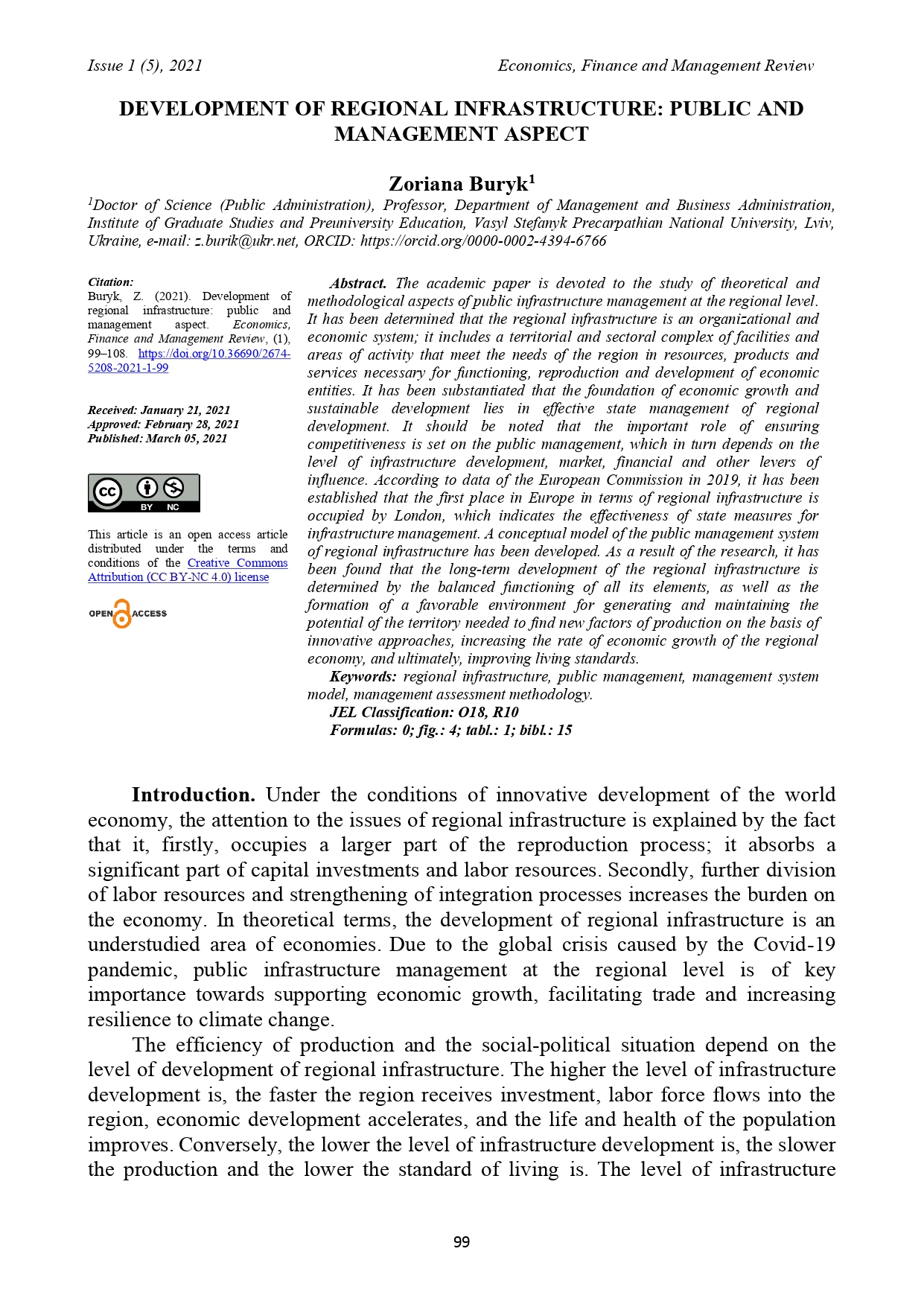DEVELOPMENT OF REGIONAL INFRASTRUCTURE: PUBLIC AND MANAGEMENT ASPECT
DOI:
https://doi.org/10.36690/2674-5208-2021-1-99Keywords:
regional infrastructure, public management, management system model, management assessment methodologyAbstract
The academic paper is devoted to the study of theoretical and methodological aspects of public infrastructure management at the regional level. It has been determined that the regional infrastructure is an organizational and economic system; it includes a territorial and sectoral complex of facilities and areas of activity that meet the needs of the region in resources, products and services necessary for functioning, reproduction and development of economic entities. It has been substantiated that the foundation of economic growth and sustainable development lies in effective state management of regional development. It should be noted that the important role of ensuring competitiveness is set on the public management, which in turn depends on the level of infrastructure development, market, financial and other levers of influence. According to data of the European Commission in 2019, it has been established that the first place in Europe in terms of regional infrastructure is occupied by London, which indicates the effectiveness of state measures for infrastructure management. A conceptual model of the public management system of regional infrastructure has been developed. As a result of the research, it has been found that the long-term development of the regional infrastructure is determined by the balanced functioning of all its elements, as well as the formation of a favorable environment for generating and maintaining the potential of the territory needed to find new factors of production on the basis of innovative approaches, increasing the rate of economic growth of the regional economy, and ultimately, improving living standards.
Downloads
References
Ari, Anil, and others (2020), “Infrastructure in Central, Eastern, and Southeastern Europe: Benchmarking, Macroeconomic Impact, and Policy Issues”, Departmental Paper, available at: https://www.elibrary.imf.org/doc/IMF087/29181-9781513550558/29181-9781513550558/Other_formats/Source_PDF/29181-9781513557779.pdf?redirect=true.
Aschauer, D (1990), “Highway Capacity and Economic Growth”, Economic Perspectives, vol.14, no.5, pp. 4–24.
Dabla-Norris, E., Brumby, J., Kyobe, A., Mills, Z., Papageorgiou, Ch. (2011), “Investing in Public Investment: An Index of Public Investment Efficiency”, available at: http://www.imf.org/en/Publications/ WP/Issues/2016/12/31/Investing-in-Public-Investment-An-Index-of-Public-Investment-Efficiency-24651.
Estache, A. & Grégoire G. (2012), “The impact of infrastructure on growth in developing countries”, IFC Economics Notes, available at: https://tinyurl.com/4ae9sc3z.
European Commission (2018), “The InvestEU Programme: Questions andanswers”, available at: https://ec.europa.eu/commission/presscorner/detail/en/memo_18_4010.
Evans, P. & Karras, G (1994), “Are Government Activities Productive? Evidence from A Panel of U.S. States”, Review of Economics and Statistics, vol. 76, pp. 1–11.
Gómez-Lobo, Andrés (2012), “Institutional Safeguards for Cost Benefit Analysis: Lessons from the Chilean National Investment System”, Journal of Benefit-Cost Analysis, vol. 3, no. 1, pp. 1–30.
Husin, A., Berawi, M., Dikun, S., Ilyas, T., & Berawi, A. (2015), “Forecasting Demand on Mega Infrastructure Projects: Increasing Financial Feasibility”, International Journal Of Technology, vol. 6, no. 1, 2015, pp. 73–83. doi:10.14716/ijtech.v6i1.782.
International Monetary Fund (2015), “Improving Public Investment Efficiency in the G-20”, available at: https://www.imf.org/external/np/pp/eng/2015/090115.pdf.
Kaufmann, D., Kraay, A. & Mastruzzi, M. (2003), “Governance Matters III: Governance Indicators for 1996–2002”, World Bank Economic Review, vol. 12, no. 12, pp. 253–287.
McKinsey Global Institute (2016), “Bridging Global Infrastructure Gaps”, available at: http://www. mckinsey.com/industries/capital-projects-and-infrastructure/our-insights/bridging-global-infrastructuregaps.
McKinsey&Company (2013), “Infrastructure Productivity: How to Save $1 Trillion a Year”, available at: https://sites.nationalacademies.org/cs/groups/pgasite/documents/webpage/pga_083856.pdf.
Morgenroth, E. (2014), “The Regional Development Impacts of Transport Infrastructure: A Literature Review and Policy Implications”, Research Series, ESRI. RePEc:esr:resser:bkmnext278.
OECD (2016), “Getting Infrastructure Right. The ten Key Governance Challenges and Policy Options”, available at: https://www.oecd.org/gov/getting-infrastructure-right.pdf.
Office for National Statistics (2018), “Experimental infrastructure statistics: dataset”, available at: https://tinyurl.com/5uu89jck.

Downloads
Published
How to Cite
Issue
Section
License

This work is licensed under a Creative Commons Attribution-NonCommercial 4.0 International License.








